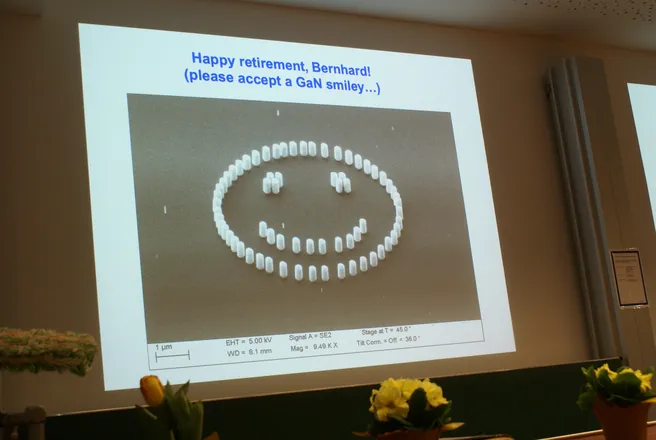On March 28, 2025, the Technical University of Munich (TUM) Department of Chemistry honored the scientific contributions and community-building achievements of retiring Prof. Bernhard Rieger.
Welcome and Opening
Prof. Tom Nilges, Head of the Department of Chemistry, opened the event with welcoming words honoring Rieger. The podium was then passed to Prof. Johannes Barth, Dean of the School of Natural Sciences, who also welcomed the audience, especially Rieger’s fellow colleagues, pointing to Rieger’s crucial mediating role as Chair and Spokesperson of the university Senate during the last presidential election and transition from Faculties to Schools at TUM. Barth gave thanks for Rieger’s “continuous engagement as a top scientist and a leader in the scientific community”.
“Bernard’s input made us think differently about the chemistry”
The colloquium began with a presentation by Prof. Jonathan Veinot (Department of Chemistry, University of Alberta, Canada), who first met Rieger at TUM getting unexpectedly “stuck” in Munich as the eruption of Icelandic volcano Eyjafjallajökull caused all flights to be cancelled for nearly a week. In his talk, “From Volcanoes to Venice and a global pandemic in between, 20 years of fun and impactful science”, Veinot reflected on both personal and scientific connections over the years. After working with Rieger during Veinot’s sabbatical at TUM in 2012, the pair solidified their collaboration. “It was such a wonderful opportunity at TUM that we wanted to share it with students, to build an extensive scientific community and do good chemistry.” Together, they founded the Alberta / Technical University of Munich Graduate School for Functional Hybrid Materials (ATUMS) in 2015 – establishing a network and opportunities for friendship between Germany and Canada that continued until November 2024.
Scientifically, early collaboration led to new insights into functionalization of photoluminescent silicon nanocrystals on surfaces, which still impacts new discoveries today, including applications in cancer research and in sensors to detect explosives. From synthesis to surface chemistry to devices, their early chance meetings at scientific conferences became a partnership between colleagues and then a community.
“A short story of Gallium Nitride”
Prof. Martin Stutzmann (Walter Schottky Institute, TUM Emeritus of Excellence) provided a historical overview of the story of GaN. From its first synthesis in the late 1930s, the material lacked immediate application. In the early 1970s, the first GaN light emitting diode (LED) was developed by University of Berkeley by Prof. Jacques I. Pankove. This device was commercially used by Volkswagen in 1980, but again without much success (the LED even had to be retrofitted to a normal light bulb with blue cover). By the early 1990s, the chemical vapor deposition system by Nichia Chemical Industries (including Nobel Laureate Shuji Nakamura) produced high-quality GaN, furthering the field. Pioneering work used a silicon substrate to grow high-quality GaN, and today it is a bustling industry.
Nowadays, GaN semiconductor devices are widespread, notably in LEDs, enabling the entire visual range at reasonable costs. Striking examples are the blue LEDs at the Pachinko gaming arcades in Japan, as well as high-electron-mobility transistor applications, found in devices such as solar-blind UV sensors and neurotransistors.
“Bernhard: the attractor, communicator, politician, scientist, entertainer, teacher, friend”
The final talk focused on the life and work of the honoree, “Bernhard Rieger, a Life dedicated to Science”. In his address, Nilges recognized both his colleague as well as the contributions of Rieger’s long-time secretary, Annette Bauer, who retires this month at the same time as the professor she worked with for decades.
A Tremendous Universe for Materials Scientists
Nilges took the audience on a time travelling journey through Rieger’s professional development, combining breakthrough scientific advancements, inventions, and collaboration with industrial partners. Nilges acknowledged Rieger first as a great scientist and as “a guy who is attached to the rest of the world”, that is, engaged with the public and connecting the academy to business. His work and acquisition of projects cumulated in initiatives like the Institute for Silicon Chemistry and iC4 that educated and developed numerous generations of scientists.
In conclusion, Nilges thanked the presenters and all participants, and acknowledged Rieger’s contributions to education, scientific progress, and building a significant collegial community. Rieger concluded the event with thanks to all presenters and guests, and a final thank you to Rieger’s right hand, Bauer, for “all the organization and support”.
During the informal reception in the lobby of the Catalysis Research Center, where Rieger worked as a primary investigator, guests had the opportunity to connect and continue the trip through time with Prof. Rieger over a shared meal and laughter.
Further information and links
- Prof. Bernhard Rieger’s research group, the WACKER Chair of Macromolecular Chemistry http://www.ch.nat.tum.de/en/makro/home/
- TUM Ambassador Prof. Jonathan Veinot “I am a Fan of TUM” http://www.community.tum.de/en/jonathan-veinot/
- TUM Catalysis Research Center http://www.crc.tum.de/en/crc/home/
- Institute for Silicon Chemistry http://www.ch.nat.tum.de/en/makro/institute-for-silicon-chemistry/home/
- ATUMS http://www.ch.nat.tum.de/en/makro/irtg-2022-atums/overview/
Press contact


